Tables sit empty at fine dining restaurants: Owners and chefs have been forced to make tough decisions due to outbreak

Many restaurants in Korea, especially the fine dining spots, are seeing their tables empty these days with people trying to refrain from getting out at all. [SHUTTERSTOCK]
As the coronavirus spreads, fine dining restaurants are being hit harder than casual spots, as going out to a nice restaurant is seen as a luxury and not essential during a time of crisis. With the government recommending that people restrict their time outside of home to stop the spread of the virus, a visit to a restaurant no longer sounds so appealing.
Plus, many local fine dining restaurants having become destinations for international travelers, who usually make up about 40 percent of overall sales, add another stress. What once provided extra financial padding for restaurants, has now become a source of loss.
Many chefs have seen reservations fall since last month, and have shared testimonies of picking up calls from people overseas explaining that their trips to Korea have been canceled altogether.
Muoki, a restaurant with one Michelin star, was one of the first in Seoul to announce that it would be shutting down temporarily. It originally stated that it would close for the entire month of March, but as the number of newly confirmed coronavirus cases has started to slow, it announced that it would reopen its doors a week early. Alla Prima, a two-Michelin-starred restaurant, also decided to close down for two weeks, until March 31. More casual restaurants by Cucciolo Group, including Cucciolo Terraza, have also closed without revealing when they plan to reopen.
“It wasn’t an easy decision to shut down, but because everyone on staff feels the drop in sales, we are trying to find ways to fight this together,” said Kim Jin-hyuk of Alla Prima, who is now trying to minimize the restaurant’s financial loss. “We all really hope that ‘revenge with expenditure’ comes after the coronavirus situation is all settled so that the restaurant staff can also feel like they are getting something in return after going through such dark times.”
Many chefs who work at fine restaurants in Korea gather regularly to share information about how to receive financial help from outside entities, including the government, and how to effectively lower costs in case they can’t shut down their restaurants temporarily. Chefs at some restaurants have agreed to exchange staffs so that young chefs can try experiencing different foods that they don’t normally get to try as there are fewer diners making reservations now. Chefs who can’t close their doors are also happy to have people fill up the seats and use up the produce they have already prepared. The staffs from each restaurant are also happy because they get to try out dishes at some of the restaurants that they may normally not be able to afford.

Above from left: Some casual spots have signs noting that they are temporarily closed in their windows; Other restaurants, like Osteria Cotto, have remained open despite the downturn in customers; Porcelain company Kwangjuyo has released a new line of dishes despite the coronavirus outbreak. [JOONGANG ILBO, OSTERIA COTTo, KWANGJUYO]
Even The Michelin Guide, a critical restaurant reviewer for chefs, made an announcement saying that the unprecedented situation presented by the coronavirus won’t make any impact on their reviews of each restaurant.
“Restaurants are all about sharing. But for now, and for an indefinite period of time, it will not be possible to go to these convivial places to admire the talent of the chefs and their team service,” Gwendal Poullennec, international director of The Michelin Guide, wrote on social media.
“When a restaurant closes for several weeks, a whole community will suffer. Not only the staff of the establishment, of course, but also the market vendors, fishermen, farmers and all the other actors who depend on the restaurant for their livelihoods.
While some are struggling to stay afloat, new restaurants haven’t been shy about gearing up for a spring bloom.
SG DineHill, a restaurant group known for its steak and Korean barbecue restaurants like Butcher’s Cut and Two Plus Deungshim, has decided to reopen its Italian restaurant Osteria Cotto after a renewal of its menu. The restaurant in Sinsa-dong, in southern Seoul’s Gangnam District, has hired a new executive chef who formally worked at The Westin Chosun Seoul to come up with dishes that are casual enough for a gathering with friends but also formal enough for special occasions.
Cheongdam 88, the sister restaurant to Seongsu-dong’s trendy Italian spot Mimachi in eastern Seoul, also opened its doors on Monday after a few weeks of a soft opening. The wine bar serves small bites inspired by Korean flavors alongside trendy natural wine.
Kitchenware companies have also continued to release new products throughout the month. Kwangjuyo, a prestigious porcelain company used by big name global chefs like Thomas Keller of The French Laundry, unveiled its new line, Baekhab, last week. The line, made up of a total of 11 items, is available in three different colors through the company’s online website, and brick and mortar stores will have the collection in stock in the coming days. White, grey and light pink dishes are available in different sizes for banchan, assorted small food items, noodles or for small desserts. The design used the motif of the shape of a clam, highlighting its natural curves and patterns.
BY LEE SUN-MIN [summerlee@joongang.co.kr]










with the Korea JoongAng Daily
To write comments, please log in to one of the accounts.
Standards Board Policy (0/250자)